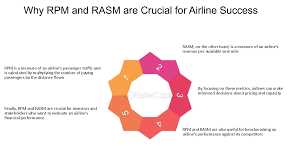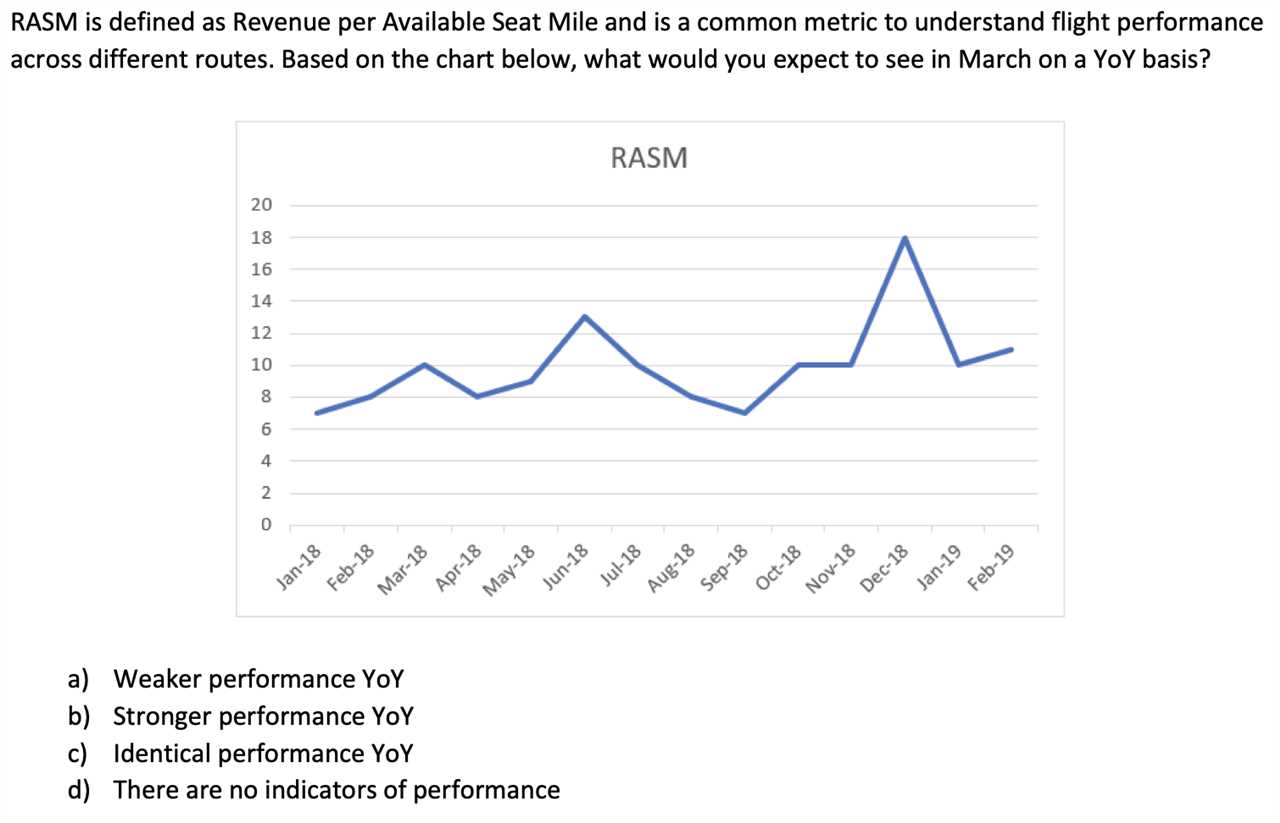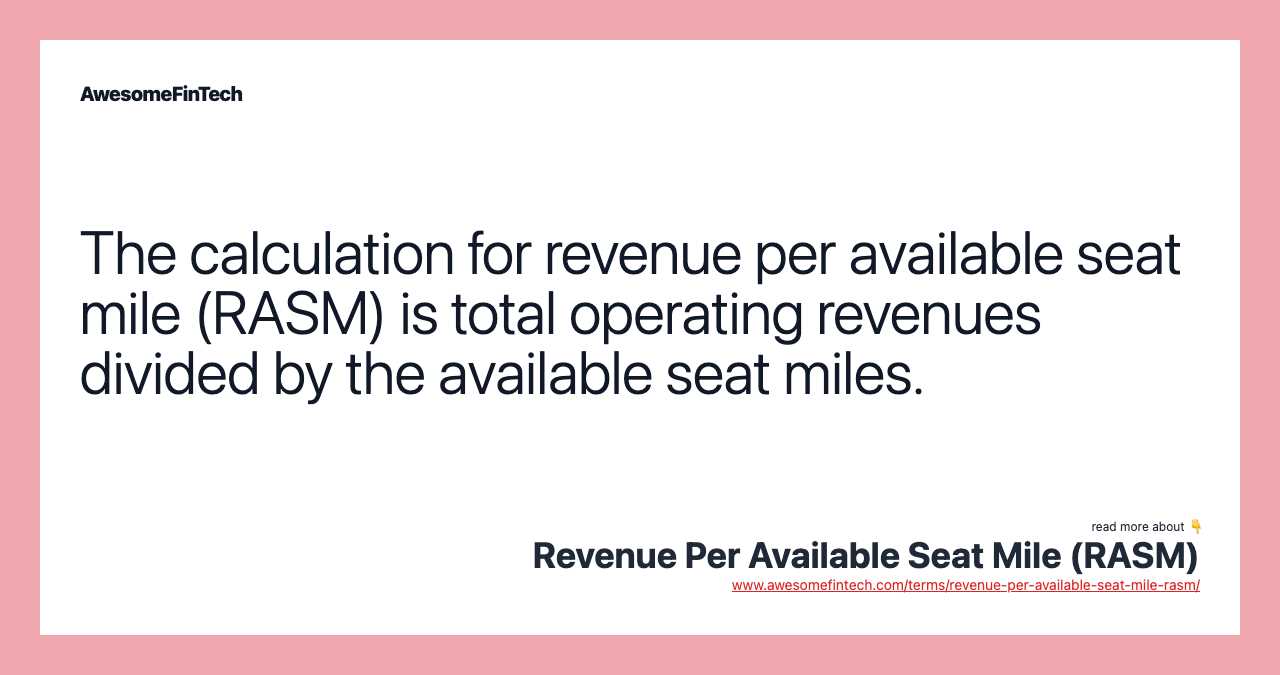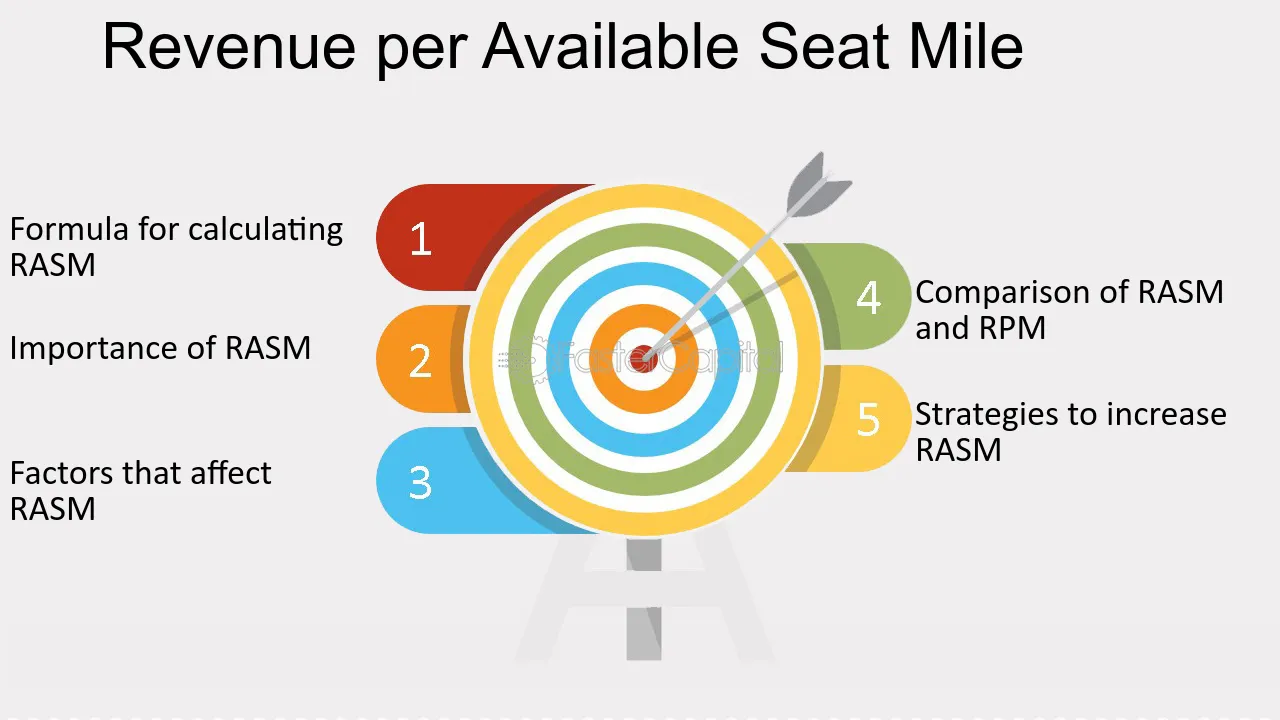What is Revenue Per Available Seat Mile (RASM)?

Revenue Per Available Seat Mile (RASM) is a key performance indicator used in the aviation industry to measure the financial performance of an airline. It is a metric that calculates the revenue generated by an airline for each seat mile available for sale.
RASM is an important metric because it helps airlines understand how effectively they are generating revenue from their available seat capacity. It takes into account both the number of seats available for sale and the revenue generated from those seats.
By calculating RASM, airlines can assess their pricing strategies, route profitability, and overall financial performance. It provides insights into the revenue generated per unit of capacity and helps airlines make informed decisions to optimize their operations and maximize profitability.
RASM is particularly useful in the airline industry because it allows airlines to compare their financial performance with competitors and benchmark their performance against industry standards. It provides a standardized metric that can be used to evaluate the financial health of an airline and identify areas for improvement.
Calculation
Calculating Revenue Per Available Seat Mile (RASM) is an important metric for airlines and other transportation sectors to measure their operational efficiency and revenue generation. RASM is calculated by dividing the total operating revenue by the total available seat miles.
Total Operating Revenue
The total operating revenue includes all the revenue generated by the transportation company from its operations. This includes revenue from ticket sales, cargo services, ancillary services, and any other sources of income.
Total Available Seat Miles

The total available seat miles represent the total number of seats available on all flights multiplied by the total number of miles flown. This metric takes into account both the capacity of the airline and the distance traveled.
Once the total operating revenue and total available seat miles are determined, the RASM can be calculated by dividing the total operating revenue by the total available seat miles.
| Total Operating Revenue | Total Available Seat Miles | RASM |
|---|---|---|
| $X | X miles | $X/mile |
For example, if an airline generates $1,000,000 in operating revenue and has a total of 1,000,000 available seat miles, the RASM would be $1 per mile.
The RASM metric is crucial for transportation companies as it helps them evaluate their revenue generation efficiency on a per mile basis. It allows them to identify areas where they can optimize their operations and increase their profitability. By monitoring and analyzing RASM, companies can make informed decisions regarding pricing, capacity management, and route planning.
Furthermore, RASM is also used by investors, analysts, and industry experts to compare the financial performance of different transportation companies within the same sector or industry. It provides a standardized metric that allows for meaningful comparisons and benchmarking.
Formula for Calculating RASM
Revenue per Available Seat Mile (RASM) is a key metric used in the aviation industry to measure the financial performance of an airline. It is calculated by dividing the total revenue generated by the airline by the total number of available seat miles.
The formula for calculating RASM is as follows:
- RASM = Total Revenue / Available Seat Miles
Where:
- Total Revenue is the sum of all the revenue generated by the airline, including passenger ticket sales, ancillary revenue, and any other sources of income.
- Available Seat Miles (ASM) is a measure of the total number of seats available on all flights multiplied by the number of miles flown.
By calculating RASM, airlines can assess their revenue generation efficiency and compare it to industry benchmarks. It provides insights into the airline’s ability to generate revenue from each seat mile available.
RASM is an important metric for airlines as it helps them evaluate their pricing strategies, optimize their route network, and make informed decisions regarding capacity planning. It also enables airlines to assess their performance relative to competitors and identify areas for improvement.
Overall, the formula for calculating RASM is a valuable tool for airlines to measure their financial performance and make data-driven decisions to enhance their revenue generation capabilities.
Overview

The Revenue Per Available Seat Mile (RASM) is a key performance metric used in various sectors and industries, particularly in the airline industry. It measures the revenue generated by an airline for each seat mile available to be sold.
RASM is an important indicator of an airline’s efficiency and profitability. It helps airlines evaluate their revenue generation capabilities and make informed decisions regarding pricing, capacity management, and route planning.
By analyzing RASM, airlines can identify areas of improvement and optimize their operations to maximize revenue. It allows them to assess the effectiveness of their pricing strategies, identify underperforming routes, and make adjustments to improve profitability.
RASM is also used by investors and analysts to evaluate the financial performance of airlines. It provides insights into an airline’s ability to generate revenue and its overall financial health.
Overall, RASM is a crucial metric that helps airlines and industry stakeholders assess and optimize revenue generation, improve profitability, and make informed business decisions.
Importance of RASM in Various Sectors & Industries
Revenue Per Available Seat Mile (RASM) is a crucial metric that is used to evaluate the financial performance of companies in various sectors and industries. It provides valuable insights into the revenue generated by each available seat mile, allowing businesses to assess their profitability and make informed decisions.
Airlines Industry
In the airlines industry, RASM is a key performance indicator that helps airlines measure their revenue generation efficiency. By analyzing RASM, airlines can identify routes or flights that are generating higher revenues per available seat mile and focus on optimizing their operations accordingly. This metric also enables airlines to compare their performance against industry benchmarks and competitors, facilitating strategic decision-making.
Hotels and Hospitality Industry

RASM is also applicable in the hotels and hospitality industry, where it helps hotels measure the revenue generated per available room. By analyzing RASM, hotels can identify peak periods and adjust their pricing strategies to maximize revenue. This metric also enables hotels to evaluate the effectiveness of their marketing campaigns and promotional activities, allowing them to make data-driven decisions to improve profitability.
Retail Industry
In the retail industry, RASM can be used to assess the revenue generated per available selling space. By analyzing RASM, retailers can evaluate the performance of different product categories or store locations and make informed decisions regarding inventory management, pricing strategies, and store layout optimization. This metric also helps retailers identify areas of improvement and implement strategies to increase revenue per available selling space.
Overall, Revenue Per Available Seat Mile (RASM) is a critical metric that provides valuable insights into the revenue generation efficiency of companies in various sectors and industries. By analyzing RASM, businesses can optimize their operations, improve profitability, and make data-driven decisions to stay competitive in the market.

Emily Bibb simplifies finance through bestselling books and articles, bridging complex concepts for everyday understanding. Engaging audiences via social media, she shares insights for financial success. Active in seminars and philanthropy, Bibb aims to create a more financially informed society, driven by her passion for empowering others.
